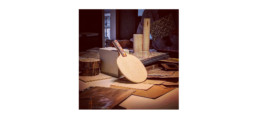At a time when constant research is continually producing new materials the Roberto Bagnato Firm of Architects sets itself apart by using sophisticated planning solutions where every detail is taken care of.
Staff at the firm receive ongoing training and, as part of this, they attended the Alpiwood training seminar on decorative wood slices.
The Roberto Bagnato Firm of Architects were thus able to build on their expertise regarding the use of wood in personalised furnishings and the application of decorative wood slices with an introduction to the latest innovations proposed by Alpiwood.

Wood slices are produced by sawing trunks of three different tree species: poplar, lime and Ayous. This produces sheets which are dyed, glued together and then cut on different slants to create a variety of decorations.
Wood sawing
How the trunk is sawn determines the type of grain the resulting sheet will have. It is vitally important to evaluate carefully how to obtain the sections in relation to the product desired.

The trunk can be sawn in different ways:
Quarter sawing produces a stripy effect: “French” or quarter sawing produces slices with stripy and parallel grains. This type of process produces sheets of slices with an especially stripy grain.
In rift sawing the log is cut along its radius, in such a way that cuts are made at right angles to the log’s growth rings. This produces sheets with a stripy grain.
Flat sawing for a flame effect
The block of wood is sawn parallel with one of its faces. Veneer is produced by sawing the half trunk parallel with its diameter. Most of the veneer produced has a tangential pattern known as “flame”. Towards the middle of the trunk, at the ends of the half trunk, the grain looks more stripy. This is because the middle of the trunk is eliminated as it has splits or darker colours which do not always lend themselves to subsequent processes. Cathedral sawing also produces a flame effect. This type of sawing differs from flat sawing because the wood is cut on a slant and not parallel with the trunk.
Rotary peeling
The log is turned and sawn tangentially into a single sheet with a thickness ranging from 2mm to 8mm. During this process too the log is placed in a bath of very hot water to prevent any fractures in the veneer.

